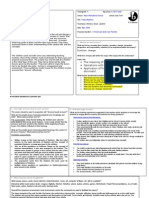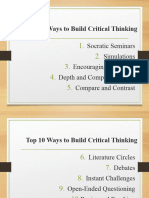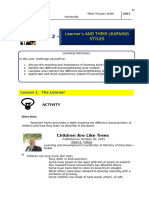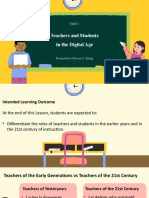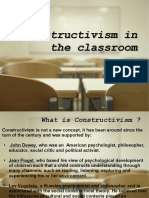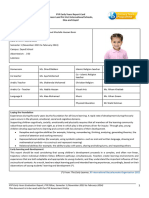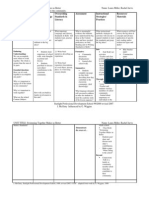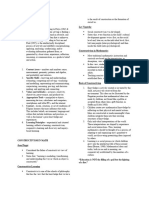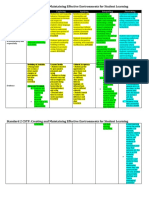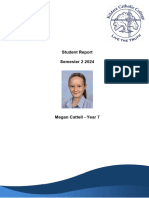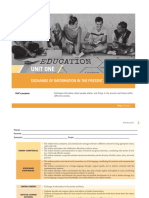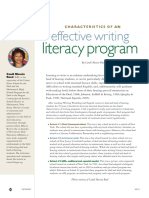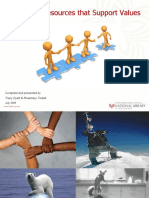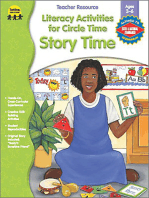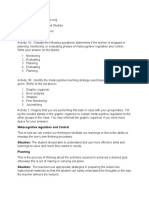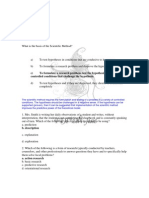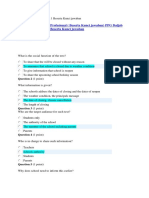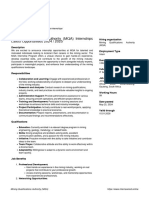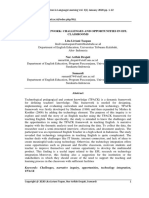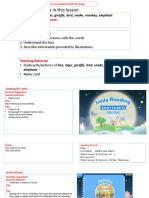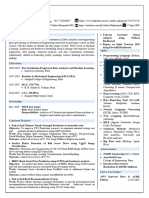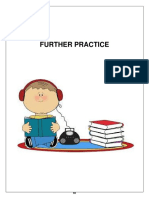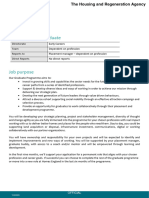Standards-Based, Thematic Units Integrate The Arts and Energize Students and Teachers
Standards-Based, Thematic Units Integrate The Arts and Energize Students and Teachers
Uploaded by
chocobo211Copyright:
Available Formats
Standards-Based, Thematic Units Integrate The Arts and Energize Students and Teachers
Standards-Based, Thematic Units Integrate The Arts and Energize Students and Teachers
Uploaded by
chocobo211Original Title
Copyright
Available Formats
Share this document
Did you find this document useful?
Is this content inappropriate?
Copyright:
Available Formats
Standards-Based, Thematic Units Integrate The Arts and Energize Students and Teachers
Standards-Based, Thematic Units Integrate The Arts and Energize Students and Teachers
Uploaded by
chocobo211Copyright:
Available Formats
may05_msj_FINAL.
qxp 4/12/2005 4:04 PM Page 9
Getting from Standards to Relevant, Challenging, Integrated, & Exploratory Curriculum
Standards-Based, Thematic Units
Integrate the Arts and Energize
Students and Teachers
By Karen Bolak, Donna Bialach, & Maureen Dunphy
I
magine a middle school where teachers and upon core curricular standards and instructional
administrators spiritedly collaborate, where methodologies reflecting best practices in middle
parents and community members enthusiastically level education.
participate, and where young adolescents eagerly • Students are eagerly engaged in the learning
engage in the learning and discovery of meaningful process and show measurable academic growth.
content, look forward to attending school, have
• Parents enthusiastically participate in the planning,
opportunities to excel, and show encouraging
implementation, and culmination of these units.
academic growth.
In our small mid-western urban school district, This vision was congruent with a major goal
a planning committee, charged with restructuring which emerged in Turning Points 2000, “to integrate
the junior high schools, read Turning Points (Carnegie what is known from education research and practice
Council on Adolescent Development, 1989) within a coherent approach toward adolescent edu-
and identified several critical issues challenging cation that educators can use in their own efforts to
our schools: transform middle grade schools” (Jackson and Davis,
2000, p. xiii).
• the educational challenges created by a gap
This article recounts our experience designing
between advantaged and disadvantaged students
a program for one of our restructured middle
• disappointing test scores schools that reflects a national movement in
• lack of teacher enthusiasm middle level reform.
• lack of parental involvement
Our Inspiration
• community dissatisfaction
A visit from Howard Gardner began our remarkable
• absence of community partnerships.
journey. Gardner (1993, 1999) believes humans possess
As a result, a group of parents, community at least eight different forms of intelligence, each
members, teachers, and administrators in our reflecting an individual’s potential to solve problems
school district combined their talents, energies, or to fashion products valued in cultural settings.
and passions to try a different way to educate our The eight intelligences are logical/mathematical,
children. They envisioned a middle school where: verbal/linguistic, musical, spatial, bodily/kinesthetic,
• Educators and community members collaborate interpersonal, intrapersonal, and naturalist. Most
to plan interdisciplinary thematic units based often teachers use instructional strategies falling
Karen Bolak, a former principal, is an assistant professor of teacher development and education studies at Oakland University,
Rochester, Michigan. E-mail: bolak@oakland.edu
Donna Bialach, a former district gifted and talented coordinator, is a lecturer in teacher development and education studies at
Oakland University, Rochester, Michigan, and an instructor in Walden University’s master of science in education program,
Minneapolis, Minnesota. E-mail: dbialach@waldenu.edu
Maureen Dunphy, a former school board member, is a special lecturer in the Department of English, Oakland University,
Rochester, Michigan. E-mail: dunphy@oakland.edu
Middle School Journal • May 2005 9
may05_msj_FINAL.qxp 4/12/2005 4:04 PM Page 10
Figure 1
Overview of Multiple Intelligences
Intelligence Key Features Examples of Activities How Students Learn Using the Intelligence
Verbal/Linguistic Make sense of the world through • Read fiction, biographies, • Students learn the elements of fiction by reading and
language and communicate. textbooks. analyzing a narrative work.
• Write poems, short stories, essays, • Students learn about life in ancient Greece by reading
or create newsletters. the Greek myths.
• Tell stories, recite poetry. • Students learn persuasive writing by reading adver-
tisements and composing their own.
Logical/Mathematical Discern logical and numerical patterns • Create a timeline. • Students learn the concept of tessellation by
and understand abstract relations. • Design a geometric pattern. studying M.C. Escher's art and designing a
• Find the answer to a logic puzzle. tessellating quilt pattern.
• Students learn simple machines by inventing a device
that uses one or more simple machines.
• Students learn the concept of gravity by calculating
weights on different planets.
Visual/Spatial Perceive visual or spatial information • Draw football game plays. • Students learn the geography of a country by
and transform this information to • Create a mind map. constructing a topographical map.
recreate visual images from memory. • Design a building. • Students learn how the economics of two countries
compare by constructing a bar graph of statistical
data.
• Students learn the dynamics of a volcano by building
a working model.
Bodily/Kinesthetic Use all or part of the body to express • Role play using process drama. • Students learn and gain perspective and empathy
ideas and feelings, create products, and • Use manipulatives. regarding issues of the Civil War era by participating
solve problems. • Participate in physical education in a process drama.
activities. • Students learn measurement by planning a menu,
shopping for ingredients, preparing and serving a
meal for their class camping experience.
• Students learn the anatomy of a frog by dissecting
one in the biology lab.
Musical/Rhythmic Create, communicate, and understand • Create an original song. • Students learn about indigenous birds by listening to
meanings using sound. • Tap out a rhythm for a dance. their song.
• Listen to instrumental music from • Students learn the state capitals by singing a song
another culture. that includes all the capitals.
• Students learn the harmonies of classical music by
listening to and analyzing Mozart etudes.
Interpersonal Recognize and make distinctions about • Work on a cooperative group project. • Students learn about the larger community by
others' feelings and intentions. • Serve on student council. participating in community service projects.
• Conduct an interview. • Students interpret expository text by analyzing it in a
cooperative group.
• Students learn how to resolve conflict by participating
in peer mediation training and mediation groups.
Intrapersonal Reflect upon perceptions, experiences, • Write in a journal. • Students learn if their eating habits promote personal
and feelings to make decisions about • Complete a self-assessment. health by collecting data for a week regarding snack
one's life and identify personal • Create a personal timeline. choices and determining their nutritional content.
strengths and weaknesses. • Students learn to evaluate their own work by using
a rubric and deciding how to improve their grade in
the future.
• Students learn to assess their own achievement level
by planning and participating in a student-led parent
conference.
Naturalist Distinguish among, classify, and use • Classify and care for plants and • Students learn about urban environmental concerns
features of the environment to exhibit animals. by designing a neighborhood plan that includes
knowledge about the natural world. • Plan/participate in a family recycling green areas, roads, housing, transportation, schools,
project. government, retail and industrial complexes, and
• Plan/participate in a school environ- recreational areas for people to live and work.
mental conservation project. • Students learn how to care for wild and domestic
animals by partnering with personnel at a shelter for
abandoned animals.
• Students learn about hydroponics by planting seeds
and growing plants without the use of soil.
(adapted from Parkay & Stanford, 2004, p. 292)
10 Middle School Journal • May 2005
may05_msj_FINAL.qxp 4/12/2005 4:04 PM Page 11
within only two of the intelligences: logical/ Hurley (2002) made a case for improving the
mathematical and verbal/linguistic (Figure 1). Con- school culture by fostering aesthetic experiences
sequently, traditional instructional strategies, narrow among staff members:
in scope, represent only part of a complete educational Because we emphasize raising students’ test scores in
program. Gardner’s (1993) theory introduced our today’s schools … aesthetic experiences provide an
community to the concept that the arts are more opportunity for principals to balance the intellectual
than an extra; they are vital to the balanced devel- and rational approaches [by] … experiencing and
opment of a child, cognitively as well as affectively. exploring human creativity. We reach our potential
We realized we were not addressing all our as we develop our aesthetic sensibilities and share
students’ learning needs because we were not them with others. (pp. 25-26)
engaging all of their intelligences. We became
convinced that the theory of multiple intelligences Applying Current Brain Research
was part of the answer to ensuring all students, Current brain research supports integrating the arts
regardless of their profile of intelligences, become with the core curriculum. Jensen (1998) repeated that,
proficient learners. “today’s biology suggests that it’s the arts that lay
the foundation for later academic and career success.
Coming Together to Design a Program A strong arts foundation builds creativity, concentra-
For our district, merging theory with practice in the tion, problem solving, self-efficacy, coordination,
schools began with a team effort by teachers, admin- and values attention and self-discipline” (p. 9).
istrators, and parents that identified our strengths as
a school district and as a community. The first of
these strengths was ethnic, racial, and socio-economic
Why not capitalize on our district strengths
diversity. The community was proud of the 31 flags by applying Gardner’s theory of multiple
gracing the high school commons that recognize the intelligences as well as current research to
heritage of each member of the student body. Being
recognized statewide for its achievements, the school
solve the educational challenges presented
district was also proud of longstanding success with by our diverse middle school learners?
its music and drama programs. The planning team
recognized that the arts employ many of the intelli-
gences identified by Gardner. For example, whereas Sylwester’s (1998) neurobiological research indicated
constructing a set for a performance relies heavily on that by using the arts, students develop a variety of
logical/mathematical and visual/spacial intelligences, channels in the brain, enhancing their ability to
choreographing and performing a dance depends on connect their learning experiences to better construct
musical, bodily/kinesthetic, visual/spatial, and inter- meaning and make sense of the world. An arts-
personal intelligences. Why not capitalize on our integrated model is also consistent with Marzano,
district strengths by applying Gardner’s theory of Pollock, and Pickering’s (2001) research synthesis on
multiple intelligences as well as current research to best classroom practices. They reviewed psychologists’
solve the educational challenges presented by our findings regarding learning through nonlinguistic
diverse middle school learners? representation or imagery. When students are
encouraged to discover and apply knowledge using
Arts Integration graphic representations or drawing, making physical
models, or engaging in kinesthetic activity, the
Integrating the arts with the core curriculum is an effects on achievement are strong. “By learning and
energizing solution at the middle level. For those practicing in the visual and performing arts, the
whose lives are richer because of a connection to the human brain actually rewires itself to make more
arts, the value of an arts-integrated academic and stronger connections” (Kolb & Whishaw, 1990
program is clear. Fowler (1994) stated, “The arts … as quoted in Chan & Petrie, 1998).
invite students to explore the emotional, intuitive,
and irrational aspects of life … while affirming the Envisioning a Paradigm Change
interconnectedness of all forms of knowing. This is
why an education without the arts is an incomplete Ultimately, district stakeholders envisioned a middle
education” (p. 9). level program that would:
Middle School Journal • May 2005 11
may05_msj_FINAL.qxp 4/12/2005 4:04 PM Page 12
• apply Gardner’s theory of multiple intelligences The principal overseeing this pilot program recog-
• include the arts as a cornerstone nized that the district strategic planning goals for
restructuring the middle schools, the CSRD grant
• transfer current middle level educational research goals, and the pilot program objectives matched.
and theory into practice Moreover, the staff’s professional development goals
• involve community partnerships were congruent with the pilot program objectives:
• employ integrated thematic units • increase achievement for all learners while
• authentically assess student learning integrating the curriculum
• create teams for program planning and • form collegial teams to transfer best practices
implementation in middle level theory to practice in the
classroom and to integrate the arts through
• choose from a variety of appropriate teaching
thematic instruction
models
• improve parental and community participation.
• provide professional development opportunities.
To manifest these goals, the pilot program principal
The thematic units would integrate content from
spearheaded a team whose members shared the
the core academic areas and extensively use four arts
belief that the responsibility for change lies with
areas to support learning. The state content standards
educators, parents, and community members who
and benchmarks in language arts, social studies,
come together believing that the effort is worthwhile
science, and math—integrated with the national
for their children.
standards in arts for music, creative movement,
visual arts, and drama—would be the starting point
for planning. The selected standards would be clearly Designing an Arts-Integrated Program
referenced. Student outcomes would be measured by: On a hot mid-August day, with water bottles every-
• rubric assessment by students and teacher where, volumes of Michigan state curricular standards
lay open on the table. Based on our understanding
• teacher-made tests of Glickman (2002), we knew that the most successful
• personal reflection by the students schools are those whose staff members share and
• national norm-referenced tests. collaborate. Thus, a team—middle school core,
visual arts, physical education, and music teachers;
After much discussion and refining of vision, we
the high school drama teacher; the district’s gifted
presented our plan to the Board of Education as a
and talented coordinator and the district’s fine arts
new district program for middle level students that
coordinator; the principal; parents; and members
would incorporate a broad range of educational goals.
of the community—began creating the first arts-
integrated thematic unit for the 51 sixth graders in
The Board Gives the Go-Ahead the pilot program.
The Board approved a one-year integrated arts pilot A teacher-friendly planning framework guided the
program for two classes of sixth grade students and process that helped meld research-based curriculum
their teachers who were headed for a restructured models with the theory of multiple intelligences.
middle school the following fall. The superintendent Student outcomes, areas of integration, focus
selected a pilot program principal who understood questions, and key concepts were clearly articulated
the importance of standards-based, integrated thematic in the framework. (See Figures 2 through 5 which
units, teaching teams, collegiality, flexibility within include some sample concepts for lesson develop-
an organization, and the value of community ment as well.) Selected standards and benchmarks
partnerships. A member of the district long-range from the core curriculum and the arts curriculum
strategic planning committee and a leader in were referenced and addressed as we developed the
professional development, the principal had just thematic units. Higher order thinking skills were
written a proposal for a Comprehensive School always considered in lesson development. Assess-
Reform Demonstration (CSRD) grant. The CSRD ment was formative and summative, standardized
grant was awarded to the district middle school and authentic. (See Figures 6 and 7 for sample
where the pilot students and teachers would be rubrics which are authentic and summative.)
placed the following year.
12 Middle School Journal • May 2005
may05_msj_FINAL.qxp 4/12/2005 4:04 PM Page 13
Figure 2
Integration Plan for Thematic Unit Using Multiple Intelligences
Integration Plan for Thematic Unit Using Multiple Intelligences Theme: Celebrating Our Cultures Grade: 6
Thematic Statement: In celebrating world cultures, we recognize and appreciate Focus Questions: Key Concepts:
(Student Outcomes) the diversity, inventiveness, and creativity of the world’s 1. How do different cultures meet their needs through invention? x Appreciation for diverse cultures
peoples. 2. How do individuals and groups within cultures construct x Geography of the Western
scientific knowledge? Hemisphere
3. How do different cultures express their beliefs and human spirit x Invention/Newton’s laws
Areas of Integration: Language Arts, Social Studies, Science, Math, Visual Arts,
through the arts?
Music, Creative Movement, and Drama. x Writing in a variety of genres
4. How do we celebrate our own culture? x Reading for a variety of purposes
x Extensive use of the arts to support
KEY: R – Required O – Optional activity S – Supporting program, learning
C – Culminating event A - Assessment
Sample concepts for lesson development:
Verbal/Linguistic Logical/Math Visual/Spatial Bodily/Kinesthetic Musical/Rhythmic Interpersonal Intrapersonal Naturalist
After doing research, Using clay, sculpt a Learn a folk dance Listen to and analyze Interview a senior After reading a book Create clay vessels.
make a pop-up book Follow a recipe to bust of a famous from a different instrumental music from citizen about life about a cultural Decorate them by
depicting scenes from make a holiday dish inventor. Make a country. Use another culture. In a before some celebration, reflect in your making impression
each celebration: for the class holiday plaque to go with it costumes/props for group, create an original modern inventions. journal about your own designs with natural
Christmas, Mexican celebration. that gives highlights of the dance and piece in the spirit of that family traditions. Discuss materials from the
Christmas, Kwanzaa, the inventor’s life. perform it at the culture. those you will carry on Western Hemisphere.
Hanukkah, and holiday celebration. when you have your own
Thanksgiving. Write a home. Describe one new
brief history and tradition you would like to
explanation of the start.
customs for each
holiday. R C A O R A R C A R A O R R
Listen to a story and Use tessellations and Make a quilted With your group Research and, if Learn about the Choose several pieces of Research how
view the quilt related measurements to hanging to give as a perform a creative possible, bring in technology that is art from Western another culture has
to the story (provided create a quilting gift. Use a basic mime to show the instruments from other available in your Hemisphere cultures that related to nature and
by the Metro Quilt pattern symbolic of a shape that represents mechanical cultures or find pictures school and reflect these emotions: how it has exhibited
Guild). Write a script culture. your holiday. movement of an of or draw the determine how it joy, fear, peace. that relationship in art,
about the quilt invention. instruments. Relate improves the music, dance, or
makers. them to more familiar learning traditions. Share your
band instruments. environment. findings with the
class.
S R O O R R O O
Research an invention Make a plan for an Design a flip-book for Create a Select a song with In a group write an Write a poem that tells Consider ways
developed in a culture invention. Describe Newton’s Laws. demonstration using “heart” in it from your adventure story about a special inventions have
outside the U.S. and the plan in writing, wind-up toys to own culture and play or related to the characteristic of your own harmed the
describe how it make the invention, illustrate Newton’s sing the song for the Western culture. environment and write
improves the quality of present to the class. Laws. class. Hemisphere. Make a proposal to reverse
life for its people. a scratchboard to the damage.
go along with the
story.
.
R R A R A R O R A R RA
Planning the First Integrated As a way of targeting these student outcomes,
Thematic Unit we composed focus questions:
After analyzing the state content standards and • How do people live and work in space?
benchmarks for each core area, the team decided • How have people explained natural phenomena
that our first thematic unit would be “Exploring the by studying the skies?
Universe” because the universe was a concept that
lent itself to integration across the disciplines. The • How have people of different cultures demon-
theme could be well supported by the arts—music, strated their interest in space and their under-
visual arts, creative movement, and drama—and standing of the universe?
would provide opportunities for engaging all the • How have the skies inspired people, from ancient
intelligences. The team developed a thematic times to the present, to express themselves
statement containing the student outcomes to through the arts?
guide our planning: The team designed instruction that was required
Through the exploration and study of the universe of all students. In addition, students could choose
we learn how people can live and work in space; from a number of alternate activities. (See “Optional”
how people, from ancient times to the present, look on unit plans, Figures 2 and 4.)
to the skies to explain natural phenomena; and how
The final unit design was a tapestry of interwoven
the heavens have provided the world’s cultures with
inspiration for the arts.
learning experiences, using all eight of the intelli-
Middle School Journal • May 2005 13
may05_msj_FINAL.qxp 4/12/2005 4:04 PM Page 14
Figure 3
Content Standards and Benchmarks Addressed in “Celebrating Our Cultures” Unit
Core Curriculum Areas: (from State Curriculum Framework (Michigan Dept. of Education, 1998))
Social Studies - Western Hemisphere: Canada, U.S., Mexico, Central America, South America
1. Locate information using a variety of print, non-print, and electronic resources.
2. Use atlas, almanac, bibliography, thesaurus, dictionary, and encyclopedia as reference tools.
3. Understand use of thematic maps to investigate the geographic, physical, and political characteristics of the Western Hemisphere.
Language Arts
1. Read and spell high-frequency words and a selected weekly list that supports and aligns with current units of study.
2. Be actively involved in writers' workshop, working through the writing process from pre-writing to publishing. Students' publications will include a variety of
genre, such as: fiction, nonfiction, poetry, biography, persuasive, and expository writing.
3. Write daily for a variety of authentic purposes, exhibiting the appropriate style, across all areas of study.
4. Identify, then use, a variety of writers' strategies (metaphors, interrupted dialogue, slow motion, threes, etc.) in his or her poetry, narrative, and when
appropriate, expository writing.
5. Maintain a journal, a note-taking notebook, and a writing portfolio.
6. Use rubrics to examine and evaluate selected pieces of his or her writing.
Genre Study
1. Understand the following literary elements: plot, characterization, setting, and theme.
2. Understand realistic fiction to help you recognize yourself and your present problems through literature characters that have been successful in
solving their problems because struggles in life are universal and no different than those encountered in literature.
3. Understand historical fiction is fiction which weaves the past with the present, and looks into the future to gain knowledge about people, values, beliefs, hard-
ships, heritage, and physical surroundings common to a period in time.
4. Understand these are types of traditional literature: folktales, fables, myths, legends, and the criteria for each type.
5. Read nonfiction to understand biography and informational text.
6. Gain knowledge about the world by reading informational books to learn about our life and world.
7. Understand biography encapsulates history, significant periods or events; study the contributions of the person and people connected with the person.
8. Explore, understand, and analyze artists' styles and use of media.
Physical Sciences: Simple Machines
1. Ask questions that help them learn about the world; design and conduct investigations using appropriate technology.
2. Analyze and explain how people of diverse cultures have contributed to and influenced developments in science.
3. Describe how things around us move and explain why things move as they do; demonstrate and explain how we control the motions of objects and relate
motion to energy and energy conversions.
Arts Curriculum Areas: (from National Standards for Arts Education (Consortium of National Arts Education Associations, 1994))
Visual Arts
1. Apply media, techniques, and processes.
2. Select materials, techniques, and processes to effectively communicate ideas.
3. Choose and evaluate a range of subject matter, symbols, and ideas.
4. Prepare and present a final product or exhibit.
5. Know and compare the characteristics of artworks in various cultures.
Creative Movement
1. Understand how to choreograph a series of movements to music.
2. Understand dance as a way to create and communicate meaning.
3. Demonstrate and understand dance in various cultures and historical periods.
Music
1. Perform on instruments, alone and with others, a varied repertoire of music.
2. Compose and arrange music within specified guidelines.
3. Understand relationships between music, the other arts, and disciplines outside the arts.
4. Understand music in relation to history and culture.
Drama
1. Develop basic acting skills to portray characters that interact in both improvised and scripted scenes.
2. Research by using cultural and historical information to support improvised and scripted scenes.
gences to provide an array of situations in which research. For example, students engaged in a
students had the opportunity to learn required simulated docking of the Hubble space telescope
content. All students would participate in a without using verbal communication. After a loss of
culminating event that demonstrated their under- visual orientation, they charted their course with a
standing and mastery of the concepts studied. In the compass. Appropriately attired and by responding to
case of the “Exploring the Universe” unit, the “virtual” technological prompts to solve problems of
culminating event involved multiple simulations of working and living in space, they experienced some
scientific concepts related to space travel and of the rigors of life in space.
14 Middle School Journal • May 2005
may05_msj_FINAL.qxp 4/12/2005 4:04 PM Page 15
Assessment was project-based and authentic, The science teacher piped up, “That’s great! We
individual, cooperative, or reflective, as appropriate. could build a small model of the space shuttle,
(See Figures 6 and 7 for sample rubrics.) A timeline using NASA’s plans. Then the students can participate
was determined, and each lesson plan was “owned” in a process drama of the docking of the Hubble,
and eventually implemented by a team member. cooperatively and non-verbally.”
A parent enthusiastically joined in, “My brother
A Peek at Our First Planning Session teaches music composition at a university. I’m sure
he’d volunteer to come and help the students
How did the team create these thematic units?
compose music related to space.”
If you had dropped in on the first unit planning
The music teacher exclaimed, “Wonderful! I’ll
meeting, you would have observed team members
e-mail him and perhaps we could work together.
engaged in a brainstorming session about how to
I will teach the students about music used in the
integrate the content standards across the disciplines
movie industry related to space. Also, I will have
under the theme exploring the universe.
them make their own instruments to use with their
The art teacher led off, “I know, I will teach a
original compositions when your brother visits.”
lesson on Van Gogh’s work. We’ll read the book,
Referencing National Standards for Arts Education
Starry Night, then create a crayon resist. That will
in creative movement, the physical education
address three content standards from the National
teacher chimed in, “The students could choreograph
Standards for Arts Education (Consortium of
and perform a routine that interprets the movement
National Arts Education Associations, 1994) while
of the planets around the sun.”
integrating the universe theme with visual arts.”
Figure 4
Integration Plan for Thematic Unit Using Multiple Intelligences
Theme: Exploring and Influencing
Integration Plan for Thematic Unit Using Multiple Intelligences Grade: 6
the Environment
Thematic Statement: Through the exploration of our physical and natural world, we Focus Questions: Key Concepts:
learn how we interact with our environment and each other to 1. How do people use maps to locate where they are on earth? x Care of the environment
(Student Outcomes) cause world change and improve the quality of life. 2. How does the natural and physical world affect human lives? x Mapping regions of the earth
3. What must happen to light in order to see objects? x Impact of technology
Areas of Integration: Language Arts, Social Studies, Science, Math, Visual Arts, 4. How and why do people from around the world exchange x Writing in a variety of genres
Music, Creative Movement, and Drama. scientific knowledge to solve problems? x Reading for a variety of purposes
x Data collection, organization, and
manipulation.
KEY: R – Required O – Optional activity S – Supporting program x Extensive use of the arts to support
C – Culminating event A - Assessment learning
Sample concepts for lesson development:
Verbal/Linguistic Logical/Math Visual/Spatial Bodily/Kinesthetic Musical/Rhythmic Interpersonal Intrapersonal Naturalist
Using technology, Locate places by Create a Build a paper mache Discuss in a group how In a group, discuss Write a diary as a Discover how color
research volcanoes in latitude and longitude topographical map of model of the volcano a region’s music reflects and list ways to scientist working to and light play a role in
different regions of the on the large world an imaginary country; you researched. Make its physical environment. improve the school develop alternate energy animal behavior.
world. Create a map; form teams to include a map key. it erupt with a playground. sources to replace fossil
poster or bulletin discuss Write a one-page vinegar/baking soda Present a proposal fuels. Describe your
board to reflect your environmental issues description of your solution. Videotape to the student excitement and
research. affecting the area. country to accompany and narrate your council. frustrations. Tell how you
your map. eruption telling how plan to share your ideas
the environment and with the world.
human life was
affected.
R A R O R C A R R R C A R A
Using technology, Over the PA and Find an article in a Visit a nature center
research how Plan a world tour; Make a flip-up chart In a group, perform a Create a rhythmic with a partner National Geographic on with your class;
scientists around the include points of that defines and non-verbal mime of a performance using a report on the an environmental issue. observe two
world address the interest, an itinerary, illustrates the five volcano eruption variety of objects to progress of your Share the article with your ecosystems; compare
problem of global and a travel budget. themes of geography. scenario. represent traveling on a class community group taking different and contrast them in
warming. Share your region’s terrain. service project. perspectives. your Naturalist’s Log.
findings with the class.
R O R A O O O R S R
Read a fictional or Take a trip to a local Compare and contrast Create a non- Reflect on ways to
realistic book on travel Use different kinds of art gallery to view In a group, create and the music from two verbal means of improve the environment Discuss with your
that tells how the lives graphs to illustrate Picasso prints. perform a skit that different regions. communication to of the region you are group how technology
of the characters were heights of volcanoes. Make Picasso-like demonstrates how the Theorize the reason for use in traveling to a visiting as a tourist and helps protect the
affected by the self-portraits using human eye uses light its distinct sound. different country write your ideas in a letter environment around
environment. concave/convex to see. and test your home to your parents. the world.
mirrors. new form of
communication
on your group.
O R A S R R R A O O
R A
Middle School Journal • May 2005 15
may05_msj_FINAL.qxp 4/12/2005 4:04 PM Page 16
Figure 5
Content Standards and Benchmarks Addressed in “Exploring and Influencing the Environment” Unit
Core Curriculum Areas: (from State Curriculum Framework (Michigan Dept. of Education, 1998))
Language Arts
Meaning and Communication
1. Read with developing fluency a variety of texts, such as short stories, novels, poetry, plays, textbooks, manuals, and periodicals.
2. Employ multiple strategies to construct meaning, such as generating questions, studying vocabulary, analyzing mood and tone, recognizing how authors use
information, generalizing ideas, matching form to content, and developing reference skills.
3. Write fluently for multiple purposes to produce compositions, such as personal narratives, persuasive essays, lab reports, and poetry.
4. Focus on meaning and communication as you listen, speak, view, read, and write in personal, social, occupational, and civic contexts.
Depth of Understanding
1. Develop a thesis using key concepts, supporting evidence, and logical argument.
Inquiry and Research
1. Define and investigate important issues and problems using a variety of resources, including technology, to explore and create texts.
Social Studies Geographic Perspective
1. Describe and compare characteristics of major world cultures including language, religion, belief systems, gender roles, and traditions.
2. Explain why people live and work as they do in different regions.
3. Explain how humans modify the environment and describe some of the possible consequences of those modifications.
4. Describe the consequences of human/environment interactions in several different types of environment.
5. Describe the geographic aspects of events taking place in different world regions.
6. Explain how elements of the physical geography, culture, and history of the region may be influencing current events.
7. Pose a social science question about a culture, world, region, or international problem.
Science
Construct New Scientific and Personal Knowledge
1. Generate scientific questions about the world based on observation.
2. Design and conduct simple investigations.
Reflecting on the Nature, Adequacy, and Connections Across Scientific Knowledge
1. Describe the advantages and risks of new technologies.
2. Recognize the contributions made in science by cultures and individuals of diverse backgrounds.
Using Scientific Knowledge from the Physical Sciences in Real-World Contexts
1. Explain how light helps us see.
2. Explain how objects or media reflect, refract, transmit, or absorb light.
Mathematics
Geometry and Measurement
1. Distinguish among shapes and differentiate between examples and non-examples of shapes based on their properties; generalize about shapes of graphs and
graph distributions.
Data Analysis and Statistics
1. Organize data using tables, charts, graphs, spreadsheets, and databases.
2. Critically read data from tables, charts, or graphs and explain the source of the data and what the data represent.
3. Formulate questions and problems and gather and interpret data to answer those questions
Arts Curriculum Areas: (from National Standards for Arts Education (Consortium of National Arts Education Associations, 1994))
Creative Movement
1. Understand dance as a way to create and communicate meaning.
2. Make connections between dance and other disciplines.
Visual Arts
1. Understand and apply media techniques and processes.
2. Understand the visual arts in relation to history and cultures.
3. Choose and evaluate a range of subject matter, symbols, and ideas.
4. Reflect upon and assess the characteristics and merits of their work and the work of others.
5. Make connections between visual arts and other disciplines.
Music
1. Evaluate music and music performances.
2. Understand music in relation to history and culture.
3. Listen to, analyze, and describe music.
Drama
1. Do script writing by the creation of improvisations and scripted scenes based on personal experience, heritage, imagination, literature, and history.
2. Act by developing basic acting skills to portray characters who interact in improvised and scripted scenes.
16 Middle School Journal • May 2005
may05_msj_FINAL.qxp 4/12/2005 4:04 PM Page 17
A classroom teacher, with the state language arts skills, expertise, talent, and availability was constructed
benchmarks open before her, added, “We’ll read The to coordinate parent volunteer efforts.
Little Prince and study the symbolism of the central Teams worked on designing units throughout the
character living on his own planet.” year (using the planning model illustrated in Figures
As the session heated up even more, another 2 through 5). The principal facilitated the process.
classroom teacher referred to math content standards She chaired meetings, kept the vision focused,
and suggested students calculate weight on different allowed for release time, and handled communication
planets. The heat outside was forgotten as a brain- between all participants, parents, and central
storming synergy flared like wildfire, generating administration. She scheduled co-teaching time
myriad exciting learning experiences to complete and found space for the many program activities.
the unit design. The principal also provided professional development
Flushed with the initial success of designing the opportunities and nurtured both team spirit and
first thematic unit, the team turned to other issues a school culture receptive to the arts-integrated
important to program start-up: parental involvement, program. As the pilot year progressed, leadership
special student needs, and the role of the larger responsibilities were shared by all team members.
community. A parent participation model based on
Figure 6
Rubric—Space Patch for NASA Uniform
Rubric
Space Patch for NASA Uniform
Criteria 4 3 2 1 Score
Space patch design reflects the Reflects both concepts with Reflects both concepts Omits one concept or Omits one concept and
concepts of working and living good detail with some detail uses very little detail uses very little detail ______ X 3 = _____
in space
Design uses geometric shapes More than two geometric Two geometric shapes One geometric shape
shapes in design in design in design ______ X 2 = _____
Original draft of design on paper Original draft includes:
• All detail of final product
• All color of final product
• Neatness One element missing Two elements missing ______ X 2 = _____
Transfer of design to cloth Used an appropriate media
technique successfully on
final product:
• Stitchery
• Acrylics Used an appropriate
• Applique media technique, but
• Fabric markers not adequately ______ X 2 = _____
Written description of patch that Writing has:
includes rationale for design and • Good paragraph structure
directions for others to follow in • Detailed description
creating the design. • Clear directions
• No spelling or grammar
errors
• Neatness Missing two or three Missing three or four
• Used Word Processor Missing one element elements elements ______ X 3 = _____
Appearance of final product
(Space Patch) • More than three colors
• Neat Missing one element ______ X 2 = _____
Comments:
Total:
Middle School Journal • May 2005 17
may05_msj_FINAL.qxp 4/12/2005 4:04 PM Page 18
Figure 7
Rubric for Volcano Project
Rubric for Volcano Project
Criteria 4 3 2 1 Score
Report • Contains new information
• Includes introduction, body, conclusion
• Includes reflection
• Written with good paragraph
construction
• No spelling or grammar errors Two or three
• Typed One element missing elements missing Four elements missing ______ X 3 = _____
Model • Neatly made
• Authentic
• Well-detailed
• Colorful Missing one element Missing two elements Missing three elements ______ X 3 = _____
Oral Presentation • Involves other students
• Smooth, organized delivery reflecting
rehearsal
• Informative Missing one element Missing two elements ______ X 2 = _____
Attractive Cover • Neat
• Four or more colors
• Includes title
• Includes author Missing one element Missing two elements Missing three elements ______ X 1 = _____
Bibliography • Neat
• Three or more sources Missing one element ______ X 1 = _____
Timeliness All four pieces submitted by
due date:
• outline
• draft
• final
• model Three on time Two on time One on time ______ X 1 = _____
Comments:
Total:
Gratifying Results roles in a variety of ways as needed. For example,
teachers and parents networked to bring in guest
As our pilot year unfolded, both students and staff “instructors.” One of the teachers invited a local
sustained enthusiasm, parents reported increased poet to present a workshop which resulted in students
student interest in attending school. Even growth compiling a book of their poems for the unit
in student socialization skills was evident. These “Exploring and Influencing the Environment.” In
outcomes resulted from: another instance, the district’s fine arts coordinator
• capable leadership managed to locate and convince a community band
• applying educational research to creative to provide music at the parent and student program
planning orientation before the school year began. This type
of leadership from the entire staff laid the ground-
• committed collegial relationships and teaming
work for individual educators to envision new ways
• wholehearted parent and community participation. of contributing to the pool of resources needed to
In addition to a capable building principal, fulfill our vision and to implement the arts-integrated
supportive central administrators, and a receptive thematic units, resulting in increased student
school board, the teaching staff assumed leadership engagement and achievement.
18 Middle School Journal • May 2005
may05_msj_FINAL.qxp 4/12/2005 4:04 PM Page 19
Such leadership, shouldered by all team members, References
led to a wider expression of effective collegial
Carnegie Council on Adolescent Development. (1989).
planning. As word leaked out about the initial
Turning points: Preparing American youth for the 21st
successes of this program, we found people century. New York: Carnegie Corporation.
approaching our doors. Seventh and eighth grade Chan, T. C., & Petrie, G. F. (1998). The brain learns better
teachers from other district schools heard about the in well-designed school environments. Classroom
program and asked to be invited to culminating Leadership On-line, 2(3), 1-3. Retrieved April 21, 2002,
events and then asked to attend the bi-monthly from http://www.ascd.org/readingroom/classlead/9811/
planning sessions. During the summer, as we 2nov98.html.
continued to receive requests by parents to place Consortium of National Arts Education Associations.
their children on our waiting list, seventh and (1994). National standards for arts education. Reston, VA:
eighth grade teachers took the initiative to plan Music Educators National Conference.
Fowler, C. (1994). Strategies for success, strong arts, strong
their own units for the next year with the help of
schools. Educational Leadership, 52(3), 4-9.
the sixth grade teachers.
Gardner, H. (1993). Frames of mind: The theory of multiple
Unit culminating events drew overwhelming intelligences (10th anniversary ed.). New York: Basic Books.
parent support and attendance. At our culminating Gardner, H. (1999). Intelligence reframed: Multiple intelli-
event for the unit “Exploring and Influencing Our gences for the 21st century. New York: Basic Books.
Environment,” 100% of our students attended Glickman, C. (2002). Leadership for learning. Alexandria, VA:
with one or more parents as well as additional Association for Supervision & Curriculum Development.
family members and friends. We also had close to Harvard Project Zero. (2000). Project SUMIT: Schools
100% participation at the other culminating events. using multiple intelligence theory (Outcomes section,
At the end of the year, standardized test results para. 1-9). Retrieved May 17, 2004, from http://
showed encouraging improvement, especially from www.pz.harvard.edu/SUMIT/OUTCOMES.HTM
Hurley, J. C. (2002). Art and human potential. Principal
students with the poorest test records. On the Stanford
Leadership, 3(4), 25.
Achievement Test, a national norm-referenced test,
Jackson, A. W., & Davis, G. A. (2000). Turning points 2000.
students’ achievement scores rose by 15% in reading New York & Westerville, OH: Teachers College Press &
and 18% in math, compared to the previous school National Middle School Association.
year. Our assessment results were consistent with the Jensen, E. (1998). Teaching with the brain in mind
research on the benefits of integrating multiple [Electronic version]. Alexandria, VA: Association
intelligences into curriculum design. The Project on for Supervision & Curriculum Development.
Schools Using Multiple Intelligences Theory (SUMIT) Retrieved April 21, 2002, from http://www.ascd.org/
was a three-year investigation of schools using multiple readingroom/books/jensen98book.html
intelligences. For this investigation, educators at 41 Marzano, R., Pollock, J. E., & Pickering, D. J. (2001).
schools were asked about how multiple intelligences Classroom instruction that works: Research-based strategies
for increasing student achievement. Alexandria, VA:
were implemented in their schools and also about
Association for Supervision & Curriculum Development.
their schools’ general make-up with regard to
Michigan Department of Education. (1998). Michigan
organization, curriculum, and assessment practices. curriculum framework. Retrieved July 14, 2004,
Twenty of the 41 schools had improved standardized from http://www.michigan.gov/documents/
test scores, 22 had improvements in discipline, and MichiganCurriculumFramework_8172_7.pdf
25 had improvement with parent participation Parkay, F. W., & Stanford B. H. (2004). Becoming a teacher
(Harvard Project Zero, 2000). (6th ed.). Boston: Pearson Education.
The arts-integrated program pilot was a success, Sylwester, R. (1998). Art for the brain’s sake. Educational
and plans were made to expand the program into Leadership, 56(3), 31-35.
the newly restructured middle school. Our experience
in designing and implementing a program that
integrates the arts with the core academic curriculum
demonstrates that it is possible to energize teachers
to provide instruction that engages students, keeps
To get ideas for using this article for staff develop-
them excited, and keeps them learning. We had ment visit www.nmsa.org and click on “Services
come together to dream of a better way to educate and Resources,” “Middle School Journal,” and
our middle level students and discovered that “Using Middle School Journal for Professional
dreams really can come true. Development,” May 2005 issue.
Middle School Journal • May 2005 19
You might also like
- Teaching to Diversity: The Three-Block Model of Universal Design for LearningFrom EverandTeaching to Diversity: The Three-Block Model of Universal Design for LearningRating: 3 out of 5 stars3/5 (2)
- UNIT II. Early Childhood Curriculum Models (Week 3-5) : Cavite State University Don Severino de Las Alas CampusDocument5 pagesUNIT II. Early Childhood Curriculum Models (Week 3-5) : Cavite State University Don Severino de Las Alas CampusFlexi Panes100% (3)
- Fractions PlannerDocument4 pagesFractions Plannernainis100% (17)
- K To 12 Pedagogical ApproachesDocument109 pagesK To 12 Pedagogical ApproachesDianne Permejo del Prado100% (3)
- Emergent Literacy (Marie Clay, 1966) : Alexandra H. AllmanDocument11 pagesEmergent Literacy (Marie Clay, 1966) : Alexandra H. AllmanSalman HasibuanNo ratings yet
- ALM Gifted Education ArticleDocument6 pagesALM Gifted Education ArticleJim WarrenNo ratings yet
- Ipp Educ32 From Aida GroupDocument8 pagesIpp Educ32 From Aida GroupKathleen SollanoNo ratings yet
- Chapter 8 Philosophies of EducationDocument10 pagesChapter 8 Philosophies of EducationMicah GuinucudNo ratings yet
- Group 1 - A4 PPT For ReportingDocument45 pagesGroup 1 - A4 PPT For ReportingJean Marie Rodrigo TripoliNo ratings yet
- Module 1 Lesson 1Document17 pagesModule 1 Lesson 1John Vincent PIEZANo ratings yet
- 21st Century TeacherDocument9 pages21st Century TeacherJade España De JesusNo ratings yet
- Ej 1098303Document6 pagesEj 1098303Ivy SalazarNo ratings yet
- Top 10 Ways To Build Critical ThinkingDocument21 pagesTop 10 Ways To Build Critical ThinkingRambo FranciscoNo ratings yet
- A Handbook of Academic LearningDocument48 pagesA Handbook of Academic Learningadeel sarwarNo ratings yet
- Kindergarten Intro Lesson Science SeasonsDocument2 pagesKindergarten Intro Lesson Science Seasonsapi-533726217No ratings yet
- Celebrations and Good Times!: Thematic UnitDocument64 pagesCelebrations and Good Times!: Thematic UnitEuge HamannNo ratings yet
- ConstructivismDocument44 pagesConstructivismlaguerta.mk2002No ratings yet
- Reflective Practice and Research: The Fair Go Research ProgramDocument31 pagesReflective Practice and Research: The Fair Go Research ProgramDrewNo ratings yet
- Unit 2 C DDocument3 pagesUnit 2 C DTatiana Mae Cruz Meneses100% (1)
- LESSON4 EDUTEP ReviewerDocument2 pagesLESSON4 EDUTEP Reviewerkabo65579No ratings yet
- Chapter 9 BissetsDocument18 pagesChapter 9 Bissetsmiey_dieyaNo ratings yet
- 608 Assessment 3Document26 pages608 Assessment 3api-487843882No ratings yet
- Comics and English Language TeachingDocument2 pagesComics and English Language TeachingThiruchelvylaxmiNo ratings yet
- Discussion 5 InclusiveDocument15 pagesDiscussion 5 InclusiveNora ZarahNo ratings yet
- Miller Mind Motivation and Meaningful Learning Strategies... - (CH1. What's The Problem)Document10 pagesMiller Mind Motivation and Meaningful Learning Strategies... - (CH1. What's The Problem)Constanza J. Cabaña AlvearNo ratings yet
- Curriculum DesignDocument94 pagesCurriculum Designgurongkalbo100% (1)
- Unit-2.-Learners-and-their-Learning-StylesDocument16 pagesUnit-2.-Learners-and-their-Learning-StylesbolanoskryzNo ratings yet
- Unit 1 - Teachers and Students in The Digital AgeDocument15 pagesUnit 1 - Teachers and Students in The Digital AgeHazel Joy CutillasNo ratings yet
- Pedagogical Approaches-KTDocument88 pagesPedagogical Approaches-KTJhing HeraNo ratings yet
- ConstructivismDocument35 pagesConstructivismFroilan TinduganNo ratings yet
- The Pillars of LearningDocument18 pagesThe Pillars of LearningAngelita LintoaNo ratings yet
- 509423065-Teaching-Intership-Learning-Task-5 (1)Document9 pages509423065-Teaching-Intership-Learning-Task-5 (1)rheaarciga15No ratings yet
- PedagogyDocument31 pagesPedagogyEugene SaldivarNo ratings yet
- Lesson 3 Building New LiteracyDocument25 pagesLesson 3 Building New Literacyomervelasquez591No ratings yet
- CGEP Framework Booklet 2020 WEB Single PageDocument8 pagesCGEP Framework Booklet 2020 WEB Single Pagedongliye040828No ratings yet
- Educ 3102 Bendebel Curriculum InnovationDocument4 pagesEduc 3102 Bendebel Curriculum InnovationStephany BendebelNo ratings yet
- PYP Early Years Report Card Green Land Pré Vert International Schools, Giza and ZayedDocument18 pagesPYP Early Years Report Card Green Land Pré Vert International Schools, Giza and ZayedNoha MostafaNo ratings yet
- TeachingpedagogyDocument17 pagesTeachingpedagogyherkamayaNo ratings yet
- Swimmy Unity MatrixDocument2 pagesSwimmy Unity Matrixrjarvis17No ratings yet
- S&E Assgn 1Document12 pagesS&E Assgn 1moniclebonNo ratings yet
- Eng P3 TGDocument177 pagesEng P3 TGMulindi Jean RégisNo ratings yet
- Philosophies of EducationDocument2 pagesPhilosophies of Educationedenfiel100% (1)
- Cooperative Learning-Based ApproachDocument22 pagesCooperative Learning-Based Approachred dela cruzNo ratings yet
- PSTM Reviewer MidtermDocument4 pagesPSTM Reviewer MidtermKlarenz DescatamientoNo ratings yet
- CSTP 2 Stephenson 3-22-2022Document14 pagesCSTP 2 Stephenson 3-22-2022api-523894066No ratings yet
- CSTP 2 Stephenson 9-5-2021Document11 pagesCSTP 2 Stephenson 9-5-2021api-523894066No ratings yet
- MKCAT22_2024_2 (1)Document11 pagesMKCAT22_2024_2 (1)cattellm1No ratings yet
- Dwnloaded LP The FunDocument8 pagesDwnloaded LP The FunSai SambasivanNo ratings yet
- CONALEP CIIN Plandeclase LiberadoDocument22 pagesCONALEP CIIN Plandeclase LiberadoLuis Antonio Diaz RosalesNo ratings yet
- Teachers As Readers: Building Communities of Readers: 2007-08 Executive SummaryDocument4 pagesTeachers As Readers: Building Communities of Readers: 2007-08 Executive SummaryGreta Gamondes100% (1)
- MODULE 2: Understanding The 21st Century Learners: Topic FrameworkDocument9 pagesMODULE 2: Understanding The 21st Century Learners: Topic FrameworkXeline Mae IdealNo ratings yet
- Characteristics of Effective Writing Literacy ProgramDocument5 pagesCharacteristics of Effective Writing Literacy Programnbookman1990No ratings yet
- BackDocument29 pagesBackapi-325749866No ratings yet
- Values & VirtuesDocument17 pagesValues & VirtuesTracy100% (2)
- Syllabus Mathematics in The Modern WorldDocument13 pagesSyllabus Mathematics in The Modern WorldRochelle TangalinNo ratings yet
- Kids Can - 1 - TRF - IntroductionDocument7 pagesKids Can - 1 - TRF - IntroductionkoraliczekNo ratings yet
- Wildcat GiftedDocument3 pagesWildcat Giftedapi-471665170No ratings yet
- EDPE 300: Exam Notes (Scott Conrod)Document17 pagesEDPE 300: Exam Notes (Scott Conrod)TrevorNo ratings yet
- Gifted Ejournal V3N1Document12 pagesGifted Ejournal V3N1aeragiftedNo ratings yet
- SY22-23 Homeroom Guidance ProgramDocument8 pagesSY22-23 Homeroom Guidance ProgramFarrah AndayaNo ratings yet
- Lesson Plan 2Document2 pagesLesson Plan 2api-336751890No ratings yet
- Synthesis and Application of Key Concepts and Principles Through Demonstration TeachingDocument39 pagesSynthesis and Application of Key Concepts and Principles Through Demonstration TeachingRica Mae Alimen100% (1)
- Matarba Primary School SIPDocument27 pagesMatarba Primary School SIPHaron HB WritersNo ratings yet
- Facilitating Chapter 3Document3 pagesFacilitating Chapter 3Jenny Rose Bimmoy Gui-ongNo ratings yet
- Sta630 McqsDocument5 pagesSta630 McqsMahmood AlqumaishNo ratings yet
- Developmental Lesson PlanDocument8 pagesDevelopmental Lesson PlanAmber ShookNo ratings yet
- We Are All Children of GodDocument2 pagesWe Are All Children of GodKath LeynesNo ratings yet
- Supervisory ManagementDocument7 pagesSupervisory ManagementMaria Danica NgoNo ratings yet
- English: Quarter 1-Module 1Document20 pagesEnglish: Quarter 1-Module 1johnvincentvilar43No ratings yet
- ppt9 Quarter2 Module1 English10Document39 pagesppt9 Quarter2 Module1 English10Jaycee Anne AregloNo ratings yet
- Fee Structure For UG 2017-18 Session PDFDocument3 pagesFee Structure For UG 2017-18 Session PDFVinodNo ratings yet
- Sumatif Learning Actifivity Part 1 Beserta Kunci JawabanDocument10 pagesSumatif Learning Actifivity Part 1 Beserta Kunci JawabanFoniamanNo ratings yet
- RMCT 00 Introduction To Module BTMDocument12 pagesRMCT 00 Introduction To Module BTMAiyas AboobakarNo ratings yet
- Lesson Plan in English 8 Unfamiliar WordsDocument3 pagesLesson Plan in English 8 Unfamiliar WordsCristine Joy GardoceNo ratings yet
- Mining Qualifications Authority Mqa Mining Qualifications Authority Mqa Internships Latest Opportunities 2024 2025 May 25 2024Document3 pagesMining Qualifications Authority Mqa Mining Qualifications Authority Mqa Internships Latest Opportunities 2024 2025 May 25 2024tshepo hlakudiNo ratings yet
- Tpack Framework Challenges and Opportunities in Ef PDFDocument22 pagesTpack Framework Challenges and Opportunities in Ef PDFJojames GaddiNo ratings yet
- AI OmanDocument9 pagesAI OmandijayNo ratings yet
- Language Items in This Lesson: Lion, Tiger, Giraffe, Bird, Snake, Monkey, Elephant We Can See A/an ..Document15 pagesLanguage Items in This Lesson: Lion, Tiger, Giraffe, Bird, Snake, Monkey, Elephant We Can See A/an ..DarklotharNo ratings yet
- DLL Mapeh-1 Q1 W6Document2 pagesDLL Mapeh-1 Q1 W6Ranjell Allain Bayona Torres100% (1)
- The Pep Dictionary of English C - PEP TALK INDIADocument132 pagesThe Pep Dictionary of English C - PEP TALK INDIADougNovatoNo ratings yet
- The Keys To Classroom ManagementDocument79 pagesThe Keys To Classroom ManagementJanice Fuerzas Balmera CuragNo ratings yet
- ATS ResumeDocument2 pagesATS ResumeGaurav PawarNo ratings yet
- Background of The Study FinalDocument8 pagesBackground of The Study FinalBIEN RUVIC MANERONo ratings yet
- Lesson Plan in Media and Information Literacy: (Have A Brief Description)Document7 pagesLesson Plan in Media and Information Literacy: (Have A Brief Description)Dandreb SardanNo ratings yet
- Deaf StudiesDocument6 pagesDeaf StudiesVangie SalvacionNo ratings yet
- Further Practice 1 & 2 - ListeningDocument3 pagesFurther Practice 1 & 2 - ListeningPhương ThảoNo ratings yet
- Education: Hope Dishman 3222 West Fern Street Muncie, IN 47304 Phone: 765-215-8889Document1 pageEducation: Hope Dishman 3222 West Fern Street Muncie, IN 47304 Phone: 765-215-8889api-263372469No ratings yet
- Graduate Job Description 2024 2Document3 pagesGraduate Job Description 2024 2Madeline JonesNo ratings yet
- Talent Management W - PokemonDocument13 pagesTalent Management W - PokemonDodi MulyantoNo ratings yet


